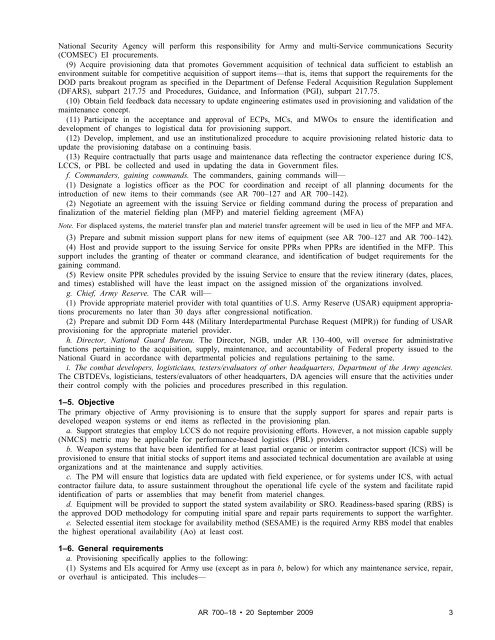Provisioning of U.S. Army Equipment - Army Publishing Directorate ...
Provisioning of U.S. Army Equipment - Army Publishing Directorate ...
Provisioning of U.S. Army Equipment - Army Publishing Directorate ...
You also want an ePaper? Increase the reach of your titles
YUMPU automatically turns print PDFs into web optimized ePapers that Google loves.
National Security Agency will perform this responsibility for <strong>Army</strong> and multi-Service communications Security<br />
(COMSEC) EI procurements.<br />
(9) Acquire provisioning data that promotes Government acquisition <strong>of</strong> technical data sufficient to establish an<br />
environment suitable for competitive acquisition <strong>of</strong> support items—that is, items that support the requirements for the<br />
DOD parts breakout program as specified in the Department <strong>of</strong> Defense Federal Acquisition Regulation Supplement<br />
(DFARS), subpart 217.75 and Procedures, Guidance, and Information (PGI), subpart 217.75.<br />
(10) Obtain field feedback data necessary to update engineering estimates used in provisioning and validation <strong>of</strong> the<br />
maintenance concept.<br />
(11) Participate in the acceptance and approval <strong>of</strong> ECPs, MCs, and MWOs to ensure the identification and<br />
development <strong>of</strong> changes to logistical data for provisioning support.<br />
(12) Develop, implement, and use an institutionalized procedure to acquire provisioning related historic data to<br />
update the provisioning database on a continuing basis.<br />
(13) Require contractually that parts usage and maintenance data reflecting the contractor experience during ICS,<br />
LCCS, or PBL be collected and used in updating the data in Government files.<br />
f. Commanders, gaining commands. The commanders, gaining commands will—<br />
(1) Designate a logistics <strong>of</strong>ficer as the POC for coordination and receipt <strong>of</strong> all planning documents for the<br />
introduction <strong>of</strong> new items to their commands (see AR 700–127 and AR 700–142).<br />
(2) Negotiate an agreement with the issuing Service or fielding command during the process <strong>of</strong> preparation and<br />
finalization <strong>of</strong> the materiel fielding plan (MFP) and materiel fielding agreement (MFA)<br />
Note. For displaced systems, the materiel transfer plan and materiel transfer agreement will be used in lieu <strong>of</strong> the MFP and MFA.<br />
(3) Prepare and submit mission support plans for new items <strong>of</strong> equipment (see AR 700–127 and AR 700–142).<br />
(4) Host and provide support to the issuing Service for onsite PPRs when PPRs are identified in the MFP. This<br />
support includes the granting <strong>of</strong> theater or command clearance, and identification <strong>of</strong> budget requirements for the<br />
gaining command.<br />
(5) Review onsite PPR schedules provided by the issuing Service to ensure that the review itinerary (dates, places,<br />
and times) established will have the least impact on the assigned mission <strong>of</strong> the organizations involved.<br />
g. Chief, <strong>Army</strong> Reserve. The CAR will—<br />
(1) Provide appropriate materiel provider with total quantities <strong>of</strong> U.S. <strong>Army</strong> Reserve (USAR) equipment appropriations<br />
procurements no later than 30 days after congressional notification.<br />
(2) Prepare and submit DD Form 448 (Military Interdepartmental Purchase Request (MIPR)) for funding <strong>of</strong> USAR<br />
provisioning for the appropriate materiel provider.<br />
h. Director, National Guard Bureau. The Director, NGB, under AR 130–400, will oversee for administrative<br />
functions pertaining to the acquisition, supply, maintenance, and accountability <strong>of</strong> Federal property issued to the<br />
National Guard in accordance with departmental policies and regulations pertaining to the same.<br />
i. The combat developers, logisticians, testers/evaluators <strong>of</strong> other headquarters, Department <strong>of</strong> the <strong>Army</strong> agencies.<br />
The CBTDEVs, logisticians, testers/evaluators <strong>of</strong> other headquarters, DA agencies will ensure that the activities under<br />
their control comply with the policies and procedures prescribed in this regulation.<br />
1–5. Objective<br />
The primary objective <strong>of</strong> <strong>Army</strong> provisioning is to ensure that the supply support for spares and repair parts is<br />
developed weapon systems or end items as reflected in the provisioning plan.<br />
a. Support strategies that employ LCCS do not require provisioning efforts. However, a not mission capable supply<br />
(NMCS) metric may be applicable for performance-based logistics (PBL) providers.<br />
b. Weapon systems that have been identified for at least partial organic or interim contractor support (ICS) will be<br />
provisioned to ensure that initial stocks <strong>of</strong> support items and associated technical documentation are available at using<br />
organizations and at the maintenance and supply activities.<br />
c. The PM will ensure that logistics data are updated with field experience, or for systems under ICS, with actual<br />
contractor failure data, to assure sustainment throughout the operational life cycle <strong>of</strong> the system and facilitate rapid<br />
identification <strong>of</strong> parts or assemblies that may benefit from materiel changes.<br />
d. <strong>Equipment</strong> will be provided to support the stated system availability or SRO. Readiness-based sparing (RBS) is<br />
the approved DOD methodology for computing initial spare and repair parts requirements to support the warfighter.<br />
e. Selected essential item stockage for availability method (SESAME) is the required <strong>Army</strong> RBS model that enables<br />
the highest operational availability (Ao) at least cost.<br />
1–6. General requirements<br />
a. <strong>Provisioning</strong> specifically applies to the following:<br />
(1) Systems and EIs acquired for <strong>Army</strong> use (except as in para b, below) for which any maintenance service, repair,<br />
or overhaul is anticipated. This includes—<br />
AR 700–18 20 September 2009<br />
3

















